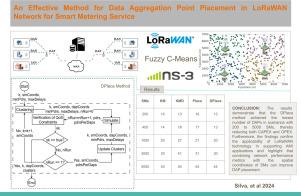一种用于智能计量服务的LoRaWAN网络数据汇聚点的有效布置方法
IF 4.3
3区 计算机科学
Q1 COMPUTER SCIENCE, INFORMATION SYSTEMS
引用次数: 0
摘要
电网已经通过智能电网(SGs)进行了重组,而先进计量基础设施(AMI)系统的部署是这一过程的基本组成部分。AMI系统由智能电表(SMs)组成,它收集能源消耗数据并通过数据聚合点(dap)将其发送给公用事业公司。因此,确定适当数量和位置的方法是必要的。在此背景下,本文提出了一种称为DAP放置(DPlace)的方法,该方法确定DAP的最小数量,并应用模糊C-Means算法将DAP定位在增强数据包成功接收的坐标上,确保智能计量应用可以通过远程广域网(LoRaWAN)网络充分传输数据。通过仿真将所提出的方法与三种最先进的解决方案进行了比较,结果表明,DPlace方法在实现通信性能(通过数据包传输比和延迟等指标进行评估)的同时,将所需的dap数量减少了37.04%,与相关方法相似,即使dap更少。本文章由计算机程序翻译,如有差异,请以英文原文为准。

An effective method for Data Aggregation Point placement in LoRaWAN network for smart metering service
Electric grids have been restructured with Smart Grids (SGs), and the deployment of Advanced Metering Infrastructure (AMI) systems is a fundamental part of this process. An AMI system consists of Smart Meters (SMs) that collect energy consumption data and send it to the utility company through Data Aggregation Points (DAPs). Thus, methods to determine the appropriate quantity and positions of DAPs become necessary. In this context, this paper proposes a method called DAP Placement (DPlace), which determines the minimum number of DAPs and applies the Fuzzy C-Means algorithm to position the DAPs at coordinates that enhance the successful reception of packets, ensuring that smart metering applications can adequately transmit data through a Long Range Wide-Area Network (LoRaWAN) network. The proposed method is compared to three state-of-the-art solutions through simulations, and the results show that the DPlace method reduces the required number of DAPs by up to 37.04% while achieving communication performance – evaluated through metrics such as packet delivery ratio and delay – similar to related methods, even with less DAPs.
求助全文
通过发布文献求助,成功后即可免费获取论文全文。
去求助
来源期刊

Computer Communications
工程技术-电信学
CiteScore
14.10
自引率
5.00%
发文量
397
审稿时长
66 days
期刊介绍:
Computer and Communications networks are key infrastructures of the information society with high socio-economic value as they contribute to the correct operations of many critical services (from healthcare to finance and transportation). Internet is the core of today''s computer-communication infrastructures. This has transformed the Internet, from a robust network for data transfer between computers, to a global, content-rich, communication and information system where contents are increasingly generated by the users, and distributed according to human social relations. Next-generation network technologies, architectures and protocols are therefore required to overcome the limitations of the legacy Internet and add new capabilities and services. The future Internet should be ubiquitous, secure, resilient, and closer to human communication paradigms.
Computer Communications is a peer-reviewed international journal that publishes high-quality scientific articles (both theory and practice) and survey papers covering all aspects of future computer communication networks (on all layers, except the physical layer), with a special attention to the evolution of the Internet architecture, protocols, services, and applications.
 求助内容:
求助内容: 应助结果提醒方式:
应助结果提醒方式:


